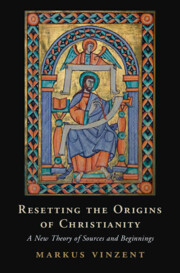29 results
Outlook
-
- Book:
- Resetting the Origins of Christianity
- Published online:
- 30 December 2022
- Print publication:
- 12 January 2023, pp 325-333
-
- Chapter
- Export citation
2 - ‘The Older, the Better’
-
- Book:
- Resetting the Origins of Christianity
- Published online:
- 30 December 2022
- Print publication:
- 12 January 2023, pp 54-117
-
- Chapter
- Export citation
Appendix
-
- Book:
- Resetting the Origins of Christianity
- Published online:
- 30 December 2022
- Print publication:
- 12 January 2023, pp 334-354
-
- Chapter
- Export citation
1 - The Romans, Christ and Paul
-
- Book:
- Resetting the Origins of Christianity
- Published online:
- 30 December 2022
- Print publication:
- 12 January 2023, pp 10-53
-
- Chapter
- Export citation
Index
-
- Book:
- Resetting the Origins of Christianity
- Published online:
- 30 December 2022
- Print publication:
- 12 January 2023, pp 390-402
-
- Chapter
- Export citation
Preface
-
- Book:
- Resetting the Origins of Christianity
- Published online:
- 30 December 2022
- Print publication:
- 12 January 2023, pp vii-xvi
-
- Chapter
- Export citation
Contents
-
- Book:
- Resetting the Origins of Christianity
- Published online:
- 30 December 2022
- Print publication:
- 12 January 2023, pp v-vi
-
- Chapter
- Export citation
4 - Scriptures and Tradition in Irenaeus and the Canonical New Testament
-
- Book:
- Resetting the Origins of Christianity
- Published online:
- 30 December 2022
- Print publication:
- 12 January 2023, pp 154-191
-
- Chapter
- Export citation
Copyright page
-
- Book:
- Resetting the Origins of Christianity
- Published online:
- 30 December 2022
- Print publication:
- 12 January 2023, pp iv-iv
-
- Chapter
- Export citation
6 - Traditions of Paul and the Ignatian Letters
-
- Book:
- Resetting the Origins of Christianity
- Published online:
- 30 December 2022
- Print publication:
- 12 January 2023, pp 248-324
-
- Chapter
- Export citation
5 - The Twelve Apostles
-
- Book:
- Resetting the Origins of Christianity
- Published online:
- 30 December 2022
- Print publication:
- 12 January 2023, pp 192-247
-
- Chapter
- Export citation
3 - The Apostolic and Prophetic Church according to Iulius Africanus, Origen and Tertullian
-
- Book:
- Resetting the Origins of Christianity
- Published online:
- 30 December 2022
- Print publication:
- 12 January 2023, pp 118-153
-
- Chapter
- Export citation
Beginnings
-
- Book:
- Resetting the Origins of Christianity
- Published online:
- 30 December 2022
- Print publication:
- 12 January 2023, pp 1-9
-
- Chapter
- Export citation
Bibliography
-
- Book:
- Resetting the Origins of Christianity
- Published online:
- 30 December 2022
- Print publication:
- 12 January 2023, pp 355-389
-
- Chapter
- Export citation

Resetting the Origins of Christianity
- A New Theory of Sources and Beginnings
-
- Published online:
- 30 December 2022
- Print publication:
- 12 January 2023
1 - Methodological Introduction
-
- Book:
- Writing the History of Early Christianity
- Published online:
- 04 March 2019
- Print publication:
- 14 March 2019, pp 5-76
-
- Chapter
- Export citation
A Short Preface at the End
-
- Book:
- Writing the History of Early Christianity
- Published online:
- 04 March 2019
- Print publication:
- 14 March 2019, pp 465-470
-
- Chapter
- Export citation
Subject Index
-
- Book:
- Writing the History of Early Christianity
- Published online:
- 04 March 2019
- Print publication:
- 14 March 2019, pp 474-486
-
- Chapter
- Export citation
2 - ‘Abercius’
-
- Book:
- Writing the History of Early Christianity
- Published online:
- 04 March 2019
- Print publication:
- 14 March 2019, pp 77-161
-
- Chapter
- Export citation
Postscript
-
- Book:
- Writing the History of Early Christianity
- Published online:
- 04 March 2019
- Print publication:
- 14 March 2019, pp 1-4
-
- Chapter
- Export citation



